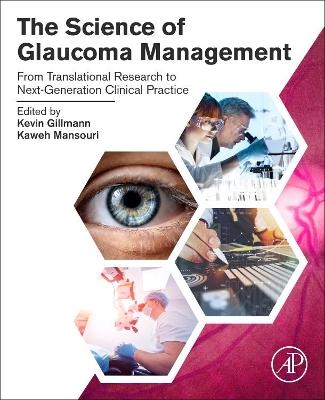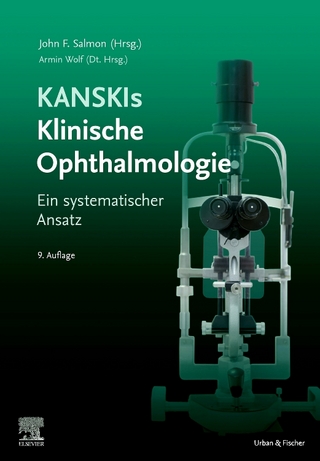
The Science of Glaucoma Management
Academic Press Inc (Verlag)
978-0-323-88442-6 (ISBN)
The book allows glaucoma specialists to explore novel ways to refine and rethink their practice based on the latest discoveries in basic sciences and breakthrough technologies, and to gain a better understanding on how their specialty is evolving and how research may shape tomorrow’s practice.
Dr Kevin Gillmann is an ophthalmologist, glaucoma specialist and researcher. He shares his clinical work between Geneva and London, where he is an honorary fellow of Moorfields Eye Hospital. He graduated from Newcastle University Medical School in 2013 (MBBS) and became a Fellow of the European Board of Ophthalmologists in 2018. In 2019, he completed his residency within Professor André Mermoud's glaucoma unit and graduated a Medical Doctorate (MD) on Minimally-Invasive Glaucoma Surgery (MIGS) from the University of Lausanne. His research with Stanford University and the Swiss Glaucoma Research Foundation focuses primarily on minimally invasive glaucoma surgery, neuroprotection and personalised glaucoma therapies. His work was featured on the frontpage of several magazines and in high-impact journals such as Nature's Eye and the British Journal of Ophthalmology, and received grants from the BrightFocus Foundation. With over 50 peer-reviewed articles, contributions to several book chapters and international guidelines, he was recently ranked amongst the top 0.5% glaucoma experts worldwide by ExpertScape. Dr Gillmann frequently gives lectures both nationally and internationally, including at the University of Liverpool and the University of London, where he was awarded a prize for academic achievements. Aside from his activities as a clinicians and educator, Dr Gillmann has also devoted some of his research to the study and improvement of patient experience in healthcare services. He was awarded a postgraduate certificate in Media and Medicine from Harvard Medical School, a Master of Business Administration (MBA) with distinctions from the University of London, and a Master of Architecture from the University of Paris LaVillette where he wrote a thesis on the interconnections between hospital design, patient perception and society. Prof. Mansouri is currently a consultant ophthalmologist at Montchoisi Clinic, Lausanne, Switzerland; and an Adjoint Professor at the Department of Ophthalmology in University of Colorado School of Medicine, Denver, USA. He pioneered the use of 24-hour IOP-monitoring technology for patients with glaucoma by contributing to the development of the IOP-sensing contact lens, Triggerfish, and was the first ophthalmologist to give a TEDx talk. A MIGS pioneer, Kaweh leads many instructional courses at international meetings and has over 75 peer-reviewed publications, including several high-profile publications and journal covers. He has contributed to a number of glaucoma textbooks, including the World Glaucoma Association Consensus Series. Prof. Mansouri is also President of the Swiss Glaucoma Research Foundation, Executive Vice President of the World Glaucoma Association, and Glaucoma Editor of the Asia-Pacific Journal of Ophthalmology.
Part 1: Currently Accepted Glaucoma Practice
1. Pathophysiology
2. Epidemiology
3. Diagnosis and investigations
4. Follow-up
5. Treatments
6. Section Summary: Discussion on the major unmet needs of the specialty
Part 2: Pathophysiology and investigation methods
7. Glaucoma epidemiology: the role of genetics and biomarkers
8. Considerations for an efficient screening programmes for glaucoma
9. Ocular perfusion in glaucoma and the role of arterial blood pressure
10. The role of circadian and extrinsic intraocular pressure fluctuations
11. Pseudo-exfoliative glaucoma: epidemiology, pathophysiology and their clinical impact
12. Retinal and optic nerve micro-perfusion and the role of OCT-A
13. Structural testing modalities: cicrumpapillary RNFL, BMO-MRW, macular RNFL or vessel density?
14. Statistical considerations on visual field testing: how frequent is frequent-enough?
15. Novelties in functional testing: the role of contrast sensitivity, electrophysiology and colour vision
16. Section Summary: Diagnosing the grey zone and follow-up considerations
Part 3: Medical and laser therapies
17. Social and psychological aspects of treatment adherence
18. Topical medications and ocular surface
19. Novel pressure-lowering medications and research alternatives
20. Novel drug delivery methods
21. Matrix metalloproteinase
22. Medical lasers, basic principles and core differences
23. Physiological principles and effects of SLT; discussion over the LIGHT Trial
24. Prophylactic iridotomy in narrow angle glaucoma
25. Aqueous dynamics, glaucoma and corneal health (considerations for iridotomies)
26. Section Summary: Recommendations in treatment-naïve open-angle glaucoma, treatment escalation protocols, and patient-specific considerations
Part 4: Surgical options
27. Anatomical, mechanical and physiological effect of cataract surgery in open and narrow angle glaucoma
28. Anatomical considerations on trabecular meshwork, Schlemm’s canal and collecting channels
29. The role of ocular inflammation, fluid dynamics and bleb morphology in surgical outcomes (including long-term conjunctival sensitization with fibroblast, aqueous inflammatory markers, and effect of aqueous flow on bleb viability; and considerations on early/delayed surgery)
30. Aqueous angiography and targeted surgery
31. Minimally-invasive glaucoma surgery (MIGS) device design considerations
32. Novel approaches to aqueous drainage
33. Adjustable drainage devices: benefits and shortcomings
34. Implantable intraocular pressure sensors and telemedicine
35. Laser-assisted surgery
36. Considerations on glaucoma clinical trials
37. Section Summary: Surgical considerations: Finding the best patient-surgeon-procedure match
Part 5: New technologies
38. Artificial intelligence and Big Data: technical considerations and clinical applications
39. Detection of apoptosing retinal cells (DARC) in glaucoma
40. Neuroprotection and neurostimulation
41. Clinical trials in neuroprotection: special considerations
42. Neuro-regeneration and stem-cell therapies
43. Gene therapy
44. Section Summary: Predicting the future of glaucoma practice
| Erscheinungsdatum | 03.04.2023 |
|---|---|
| Zusatzinfo | 100 illustrations (50 in full color); Illustrations |
| Verlagsort | Oxford |
| Sprache | englisch |
| Maße | 216 x 276 mm |
| Gewicht | 1310 g |
| Themenwelt | Medizin / Pharmazie ► Medizinische Fachgebiete ► Augenheilkunde |
| Naturwissenschaften ► Biologie | |
| ISBN-10 | 0-323-88442-3 / 0323884423 |
| ISBN-13 | 978-0-323-88442-6 / 9780323884426 |
| Zustand | Neuware |
| Haben Sie eine Frage zum Produkt? |
aus dem Bereich


